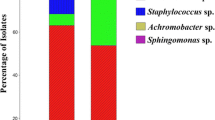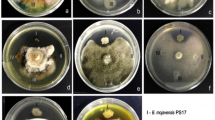Abstract
Fusarium oxysporum f. sp. cucumerinum is a destructive pathogen on cucumber (Cucumis sativus L.) seedlings and the causal organism of crown and root rot of cucumber plants. An isolate of B579, which was identified as Bacillus subtilis by 16S rDNA sequences analysis, was selected from 158 bacteria isolates as the best antagonist against F. oxysporum by dual plate assay. The production of chitinase, β-1, 3-glucanase, siderophores, indole-3-acetic acid (IAA), hydrogen cyanide (HCN), and phosphate solubilization, by B579 were screened with the selected medium by in vitro tests. The cell-free culture filtrate of B579, with a concentration of 20% (v/v), could result in the vacuolation, swelling and lysis of hyphae. Besides, it could blacken, shrunk and hindered the germination of conidia of F. oxysporum at the concentration of ≥80% (v/v). When applied as inoculants, B579 (108 c.f.u. ml−1) was able to reduce disease incidence by 73.60%, and promote seedling growth in pot trial studies. The activities of plant defense-related enzyme, peroxidase (POX), polyphenol oxidase (PPO) and phenylalanine ammonia-lyase (PAL) were significantly increased in plants treated with B579. Interestingly, a higher content of IAA, an important plant growth regulator, was detected in B579 treated plants. Furthermore, seed-soaking with B579 exhibited a better biological control effect (Biocontrol effect 73.60%) and plant growth promoting ability (Vigor Index 4,177.53) than root-irrigation (50.88% and 3,575.77, respectively), suggesting the potential use of B579 as a seed-coating agent.





Similar content being viewed by others
References
Abdul-Baki AA, Anderson JD (1973) Vigor determination in soybean seed by multiple criteria. Crop Sci 13:630–633
Ahn IP, Chung HS, Lee YH (1998) Vegetative compatibility groups and pathogenicity among isolates of Fusarium oxysporum f. sp. cucumerinum. Plant Dis 82:244–246
Asghar HN, Zahir ZA, Arshad M, Khaliq A (2002) Relationship between in vitro production of auxins by rhizobacteria and their growth-promoting activities in Brassica juncea L. Biol Fertil Soils 35:231–237
Ashrafuzzaman M, Hossen Farid Akhtar, Razi Ismail M, Md Anamul Hoque, Zahurul Islam M, Shahidullah SM, Meon Sariah (2009) Efficiency of plant growth-promoting rhizobacteria (PGPR) for the enhancement of rice growth. Afr J Biotechnol 8:1247–1252
Baysal Ö, Caliskan M, Yesilova Ö (2009) An inhibitory effect of a new Bacillus subtilis strain (EU07) against Fusarium oxysporum f. sp. radicis-lycopersici. Physiol Mol Plant Pathol (in press)
Brannen PM, Kenney DS (1997) Kodiak—a successful biological-control product for suppression of soil-borne plant pathogens of cotton. J Ind Microbiol Biotech 19:169–171
Cattelan AJ, Hartel PG, Fuhrmann JJ (1999) Screening for plant growth-promoting rhizobacteria to promote early soybean growth. Soil Sci Soc Am J 63:1670–1680
Choudhary DK and Johri BN (2008) Interactions of Bacillus spp. and plants—with special reference to induced systemic resistance (ISR). Microbiol Res (in press)
Chung S, Kong H, Buyer JS, Lakshman DK, Lydon J, Kim SD, Roberts DP (2008) Isolation and partial characterization of Bacillus subtilis ME488 for suppression of soilborne pathogens of cucumber and pepper. Appl Microbiol Biotechnol 80:115–123
Fravel D, Olivain C, Alabouvette C (2003) Fusarium oxysporum and its biocontrol. New Phytol 157:493–502
Fu JM, Huang BR (2001) Involvement of antioxidants and lipid peroxidation in the adaptation of two cool-season grasses to localized drought stress. Environ Exp Bot 45:105–114
Glick BR (1995) The enhancement of plant growth by free-living bacteria. Can J Microbiol 41:109–117
Gordon SA, Weber RP (1951) Colorimetric estimation of indoleacetic acid. Plant Physiol 26:192–195
Grossman TH, Trukman M, Ellestad S, Osburne MS (1993) Isolation and characterization of Bacillus subtilis genes involved in siderophore biosynthesis; relationship between B. subtilis sfro and E. coli entD genes. J Bacteriol 175:6203–6211
Gupta A, Meyer JM, Goel R (2002) Development of heavy metal-resistant mutants of phosphate solubilizing Pseudomonas sp. NBRI 4014 and their characterization. Curr Microbiol 45:323–327
ISTA (1966) International rules for seed testing. Proc Int Seed Test Assoc 31:1–152
Jayaraj J, Yi H, Liang GH, Muthukrishnan S, Velazhahan R (2004) Foliar application of Bacillus subtilis AUBS1 reduces sheath blight and triggers defense mechanisms in rice. J Plant Dis Prot 111:115–125
Kloepper JW, Rodriguez-Ubana R, Zehnder GW, Murphy JF, Sikora E, Fernandez C (1999) Plant root bacterial interactions in biological control of soil borne diseases and potential extension to systemic and foliar diseases. Austr Plant Pathol 28:21–26
Kloepper JW, Ryu CM, Zhang S (2004) Induced systemic resistance and promotion of plant growth by Bacillus spp. Phytopathology 94:1259–1266
Koike N, Hyakumachi M, Kageyama K, Doke N (2001) Induction of systemic resistance in cucumber against several diseases by plant growth-promoting fungi: lignification and superoxide generation. Eur J Plant Pathol 107:523–533
Lee HJ, Park KH, Shim JH, Park RD, Kim YW, Cho JY, Hwangbo H, Kim YC, Cha GS, Krishana H, Kim KY (2005) Quantitative changes of plant defense enzymes in biocontrol of pepper (Capsicium annuum L.) late blight by antagonistic Bacillus subtilis HJ927. J Microbiol Biotechnol 15:1073–1079
Lee KJ, Kamala-Kannan S, Sub HS, Seong CK, Lee GW (2008) Biological control of Phytophthora blight in red pepper (Capsicum annuum L.) using Bacillus subtilis. World J Microbiol Biotechnol 24:1139–1145
Leelasuphakul W, Sivanunsakul P, Phongpaichit S (2006) Purification, characterization and synergistic activity of β-1, 3-glucanase and antibiotic extract from an antagonistic Bacillus subtilis NSRS 89–24 against rice blast and sheath blight. Enzyme Microb Tech 38:990–997
Li JC, Shi J, Zhao XL, Wang G, Yu HF, Ren YJ (1994) Separation and determination of three kinds of plant hormones by high-performance liquid chromatography. Chinese J Anal Chem 22:801–804 (in Chinese)
Li W, Hu JC, Wang SJ (2008a) Growth-promotion and biocontrol of cucumber fusarium wilt by marine Bacillus subtilis 3512A. J Shenyang Agric Univ 39:182–185 (in Chinese)
Li SM, Hua GG, Liu HX, Guo JH (2008b) Analysis of defence enzymes induced by antagonistic bacterium Bacillus subtilis strain AR12 towards Ralstonia solanacearum in tomato. Ann Microbiol 58:573–578
Manjula K, Podile AR (2005) Increase in seedling emergence and dry weight of pigeon pea in the field with chitin-supplemented formulations of Bacillus subtilis AF 1. World J Microbiol Biotechnol 21:1057–1062
Mohammadi M, Kazemi H (2002) Changes in peroxidase and polyphenol oxidase activities in susceptible and resistant wheat heads inoculated with Fusarium graminearum and induced resistance. Plant Sci 162:491–498
Nagorska K, Bikowski M, Obuchowskji M (2007) Multicellular behaviour and production of a wide variety of toxic substances support usage of Bacillus subtilis as a powerful biocontrol agent. Acta Biochim Pol 54:495–508
Park YS (1999) Carbon dioxide-induced flesh browning development as related to phenolic metabolism in ‘Niitaka’ pear during storage. J Kor Soc Hort Sci 40:567–570
Pikovaskaya RI (1948) Mobilization of phosphorus in soil in connection with vital activity of some microbial species. Mikrobiologiya 17:362–370
Podile AR, Laxmi VDV (1998) Seed bacterization with Bacillus subtilis AF 1 increase phenylalanine ammonialyase and reduces the incidence of fusarial wilt in pigeonpea. J Phytopathol 146:255–259
Podile AR, Prasad GS, Dube HC (1987) Partial characterization of the antagonistic principle of Bacillus subtilis AF 1. J Biol Control 1:60–65
Qi XC (2006) Cloning of promoter fragment from Bacillus subtilis and its application in tagging with GFP. Dissertation, China Agriculture University (in Chinese)
Rothrock CS (1987) Take-all of wheat as affected by tillage and wheat-soybean double cropping. Soil Biol Biochem 19:307–311
Ryu CM, Murphy JF, Reddy MS et al (2007) A two-strain mixture of rhizobacteria elicits induction of systemic resistance against Pseudomonas syringae and Cucumber Mosaic Virus coupled to promotion of plant growth on Arabidopsis thaliana. J Microbiol Biotechnol 17:280–286
Schwyn B, Neilands JB (1987) Universal chemical assay for the detection and determination of siderophores. Anal Biochem 160:47–56
Sherf AF and MacNab AA (1986) Fusarium wilt of muskmelon. In: Vegetable diseases and their control, 2nd edn. Wiley, New York, 334–337
Singh N, Pandey P, Dubey RC, Maheshwari DK (2008) Biological control of root rot fungus Macrophomina phaseolina and growth enhancement of Pinus roxburghii (Sarg.) by rhizosphere competent Bacillus subtilis BN1. World J Microbiol Biotechnol 24:1669–1679
Szczech M, Shoda M (2006) The effect of mode of application of Bacillus subtilis RB14-C on its efficacy as a biocontrol agent against Rhizoctonia solani. J Phytopathol 154:370–377
Thilagavathi R, Saravanakumar D, Ragupathi N, Samiyappan R (2007) A combination of biocontrol agents improves the management of dry root rot (Macrophomina phaseolina) in greengram. Phytopathol Mediterr 46:157–167
Wang XL (2008) Study on liquid fermentation technology of Bacillus B579 and its living preparation. Dissertation, Tianjin University of Science and Technology (in Chinese)
Zdor RE, Anderson AJ (1992) Influence of root colonizing bacteria on the defense responses of bean. Plant Soil 140:99–107
Acknowledgments
This work was supported by the Natural Science Foundation of Tianjin, China (Project No. 09JCZDJC19100).
Author information
Authors and Affiliations
Corresponding author
Rights and permissions
About this article
Cite this article
Chen, F., Wang, M., Zheng, Y. et al. Quantitative changes of plant defense enzymes and phytohormone in biocontrol of cucumber Fusarium wilt by Bacillus subtilis B579. World J Microbiol Biotechnol 26, 675–684 (2010). https://doi.org/10.1007/s11274-009-0222-0
Received:
Accepted:
Published:
Issue Date:
DOI: https://doi.org/10.1007/s11274-009-0222-0




